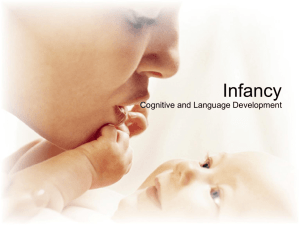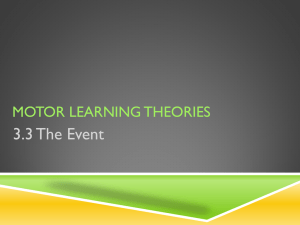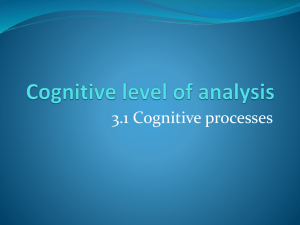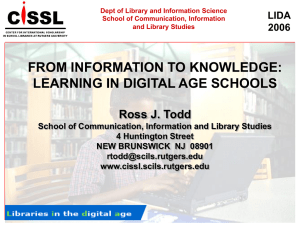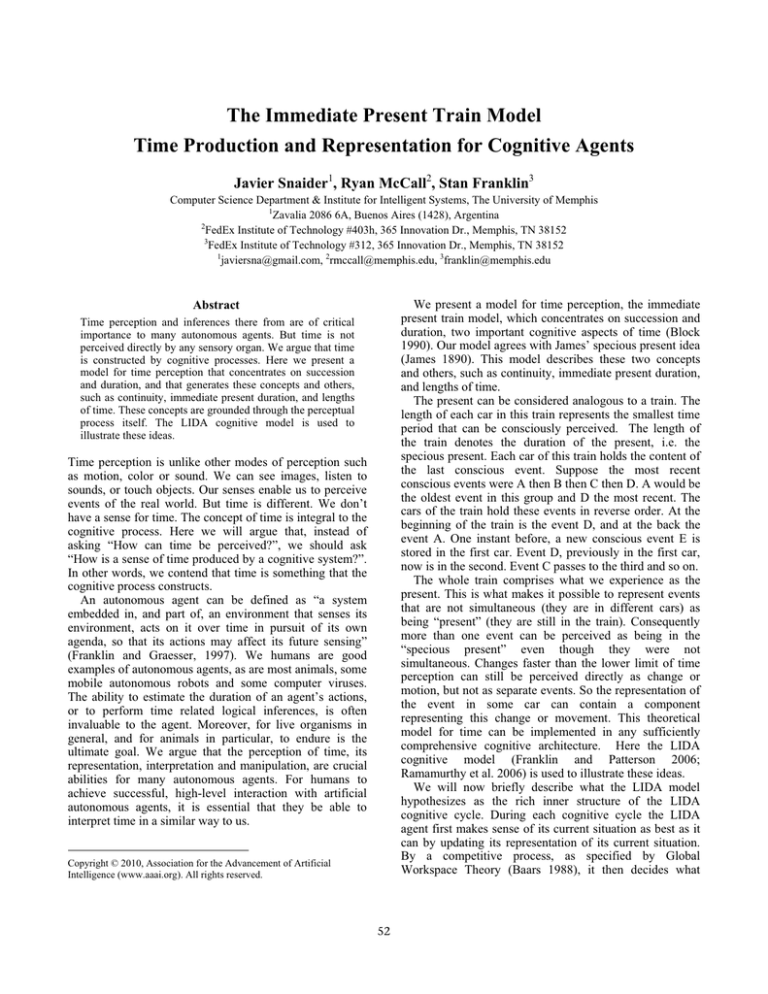
The Immediate Present Train Model
Time Production and Representation for Cognitive Agents
Javier Snaider1, Ryan McCall2, Stan Franklin3
Computer Science Department & Institute for Intelligent Systems, The University of Memphis
1
Zavalia 2086 6A, Buenos Aires (1428), Argentina
2
FedEx Institute of Technology #403h, 365 Innovation Dr., Memphis, TN 38152
3
FedEx Institute of Technology #312, 365 Innovation Dr., Memphis, TN 38152
1
javiersna@gmail.com, 2rmccall@memphis.edu, 3franklin@memphis.edu
We present a model for time perception, the immediate
present train model, which concentrates on succession and
duration, two important cognitive aspects of time (Block
1990). Our model agrees with James’ specious present idea
(James 1890). This model describes these two concepts
and others, such as continuity, immediate present duration,
and lengths of time.
The present can be considered analogous to a train. The
length of each car in this train represents the smallest time
period that can be consciously perceived. The length of
the train denotes the duration of the present, i.e. the
specious present. Each car of this train holds the content of
the last conscious event. Suppose the most recent
conscious events were A then B then C then D. A would be
the oldest event in this group and D the most recent. The
cars of the train hold these events in reverse order. At the
beginning of the train is the event D, and at the back the
event A. One instant before, a new conscious event E is
stored in the first car. Event D, previously in the first car,
now is in the second. Event C passes to the third and so on.
The whole train comprises what we experience as the
present. This is what makes it possible to represent events
that are not simultaneous (they are in different cars) as
being “present” (they are still in the train). Consequently
more than one event can be perceived as being in the
“specious present” even though they were not
simultaneous. Changes faster than the lower limit of time
perception can still be perceived directly as change or
motion, but not as separate events. So the representation of
the event in some car can contain a component
representing this change or movement. This theoretical
model for time can be implemented in any sufficiently
comprehensive cognitive architecture. Here the LIDA
cognitive model (Franklin and Patterson 2006;
Ramamurthy et al. 2006) is used to illustrate these ideas.
We will now briefly describe what the LIDA model
hypothesizes as the rich inner structure of the LIDA
cognitive cycle. During each cognitive cycle the LIDA
agent first makes sense of its current situation as best as it
can by updating its representation of its current situation.
By a competitive process, as specified by Global
Workspace Theory (Baars 1988), it then decides what
Abstract
Time perception and inferences there from are of critical
importance to many autonomous agents. But time is not
perceived directly by any sensory organ. We argue that time
is constructed by cognitive processes. Here we present a
model for time perception that concentrates on succession
and duration, and that generates these concepts and others,
such as continuity, immediate present duration, and lengths
of time. These concepts are grounded through the perceptual
process itself. The LIDA cognitive model is used to
illustrate these ideas.
Time perception is unlike other modes of perception such
as motion, color or sound. We can see images, listen to
sounds, or touch objects. Our senses enable us to perceive
events of the real world. But time is different. We don’t
have a sense for time. The concept of time is integral to the
cognitive process. Here we will argue that, instead of
asking “How can time be perceived?”, we should ask
“How is a sense of time produced by a cognitive system?”.
In other words, we contend that time is something that the
cognitive process constructs.
An autonomous agent can be defined as “a system
embedded in, and part of, an environment that senses its
environment, acts on it over time in pursuit of its own
agenda, so that its actions may affect its future sensing”
(Franklin and Graesser, 1997). We humans are good
examples of autonomous agents, as are most animals, some
mobile autonomous robots and some computer viruses.
The ability to estimate the duration of an agent’s actions,
or to perform time related logical inferences, is often
invaluable to the agent. Moreover, for live organisms in
general, and for animals in particular, to endure is the
ultimate goal. We argue that the perception of time, its
representation, interpretation and manipulation, are crucial
abilities for many autonomous agents. For humans to
achieve successful, high-level interaction with artificial
autonomous agents, it is essential that they be able to
interpret time in a similar way to us.
Copyright © 2010, Association for the Advancement of Artificial
Intelligence (www.aaai.org). All rights reserved.
52
portion of the represented situation is most in need of
attention. Broadcasting this portion, the current contents of
consciousness, enables the agent to chose an appropriate
action and execute it, completing the cycle. Thus the LIDA
cognitive cycle can be subdivided into three phases, the
understanding phase, the attention (consciousness) phase,
and the action selection phase.
We will describe the understanding and attention phases
in more detail due to their relevance to this work. Starting
the understanding phase, incoming stimuli activate lowlevel feature detectors in Sensory Memory. The output is
sent to Perceptual Associative Memory where higher-level
feature detectors feed into more abstract entities such as
objects, categories, actions, events, etc. These entities are
represented by nodes and links. The resulting percept
moves to the Workspace where it cues both Transient
Episodic Memory and Declarative Memory producing
local associations that are combined with the percept to
generate a current situational model, the agent’s
understanding of what is going on right now. In the
subsequent attention phase, coalitions are formed of
selected portions of the current situational model and are
moved to the Global Workspace. A competition in the
Global Workspace then selects the most salient coalition
whose contents become the content of consciousness.
These conscious contents are then broadcast globally.
A new component of the LIDA workspace, the
Conscious Contents Queue (CCQ), has been added to its
architecture, permitting the agent to give meaning to time
concepts. Nodes in LIDA are perceptual symbols (Barsalou
2008). These nodes are ultimately grounded in sensory
feature detectors. Objects are grounded exclusively in
sensory feature detectors, but some additional mechanism
is needed to ground the notions of time and time
representations. We argue that nodes of time
representations are grounded in the order and duration of
perceptual events. These nodes are produced by codelets
using material from the CCQ. A codelet is a small piece of
code that performs a specific task in an independent way.
With each new conscious broadcast, the current contents
of consciousness is added as an element to the queue, and
the previous elements of the queue pass to the next position
(toward the “end” of the queue). Codelets can directly
access any position in the queue.
The CCQ and the LIDA cognitive cycle determine the
time scale of which the agent is directly aware. The lower
limit of time perception would be determined by the length
of the interpreting phase of a cognitive cycle (~100ms in
humans), and would coincide with the duration assigned to
one position in the CCQ. The upper limit would be
determined by the number of positions retained in this
queue. Changes occurring on timescales faster than a
cognitive cycle phase (~100ms) can still be perceived
directly. A common example of this is the direct
perception of a moving object. The movement itself is
represented by a node that enters the workspace linked
with the node representing the object. It could be chosen to
be broadcast as conscious content. In this way, the CCQ
holds the recent contents of consciousness, but not as static
“pictures.” Rather it stores the change and movement
associated with its elements.
Codelets can use the contents of the CCQ to ascertain
temporal events. For example, a codelet could detect that
some consecutive positions in the CCQ contain an object
element. Then that codelet might create a representation of
the object being present for a period of time, for example,
for one second. The resulting representation could be then
added to the agent’s current situational model. In the same
way, codelets working on the CCQ can detect and produce
nodes for time periods of a few seconds in length. Then
the abstract node “Time duration” could appear
categorizing them, and an even more abstract node for
“Time” could also be generated. Finally long-term nodes
for periods of, 1hour, 1 day, 1 year, a century, could be
created. Codelets can also provide a mechanism for
temporal reasoning. They can detect similarities, changes,
and even cause-effect relations between elements in the
CCQ, and in the current situational model.
The immediate present train model explains the
construction of representations of events and their time
related attributes by cognitive agents. This construction, in
turn, permits the agent to understand situations and how
they change over time. Similarly, this model allows the
agent to reason about the future, creating expectations that
represent possible future states based in the actual
situation. These are the bare bones of time perception.
Many time-related processes can be explained with this
model. Finally, it opens the door to more sophisticated
processes like deliberation and metacognition.
References
Baars, B. J. 1988. A cognitive theory of consciousness.
Cambridge: Cambridge University Press.
Barsalou, L. W. 2008. Grounded Cognition. Annual
Review of Psychology, 59, 617–645.
Block, R. 1990. Cognitive Models of Psychological Time.
Lawrence Erlbaum Associates. Hillsdale, NJ.
Franklin, S.; and Graesser, A. C. 1997. Is it an Agent, or
just a Program?: A Taxonomy for Autonomous Agents
Intelligent Agents III (pp. 21–35). Berlin: Springer Verlag.
Franklin, S.; and Patterson, F. G. Jr. 2006. The LIDA
architecture: Adding new modes of learning to an
intelligent, autonomous, software agent. In Idpt-2006
proceedings (integrated design and process technology):
Society for Design and Process Science.
James, W. 1890. The principles of psychology. Cambridge,
MA: Harvard University Press.
Ramamurthy, U.; Baars, B. J.; D'Mello, S. K.; and
Franklin, S. 2006. LIDA: A Working Model of Cognition.
In D. Fum, F. Del Missier & A. Stocco (Eds.), Proceedings
of the 7th International Conference on Cognitive Modeling
(pp. 244–249). Trieste: Edizioni Goliardiche.
53




